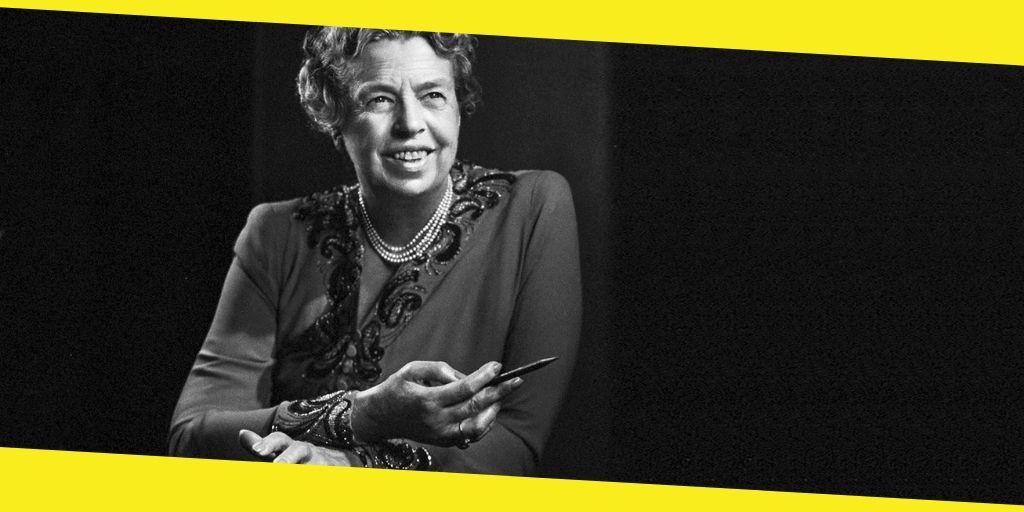Eleanor Roosevelt and Women’s Rights

For countless Americans who lived through World War II and the Great Depression, Eleanor Roosevelt was a source of hope and inspiration. This unconventional First Lady entered the White House in 1933 as a figure of support for the disabled President Franklin D. Roosevelt. She went on to reshape the role of First Lady, becoming a notable speaker and an active supporter of women’s rights and civil rights movements.
During her tenure, Eleanor Roosevelt hosted hundreds of press conferences, including one in 1933 where she only invited female reporters to the White House at a time when female journalists were barred from entering the place. She also hosted weekly radio shows, authored daily newspaper and magazine columns, and traveled over 40,000 miles every year, meeting fellow citizens and soldiers across the world.
Although Eleanor Roosevelt is most famous for co-drafting the ‘Universal Declaration of Human Rights’ for the United Nations General Assembly, it’s her role as a leader of several women’s rights movements that Americans look back on as some of her most impactful achievements. To know about how she felt about the importance of female liberation, all we need to do is read Eleanor Roosevelt quotes about women. Here are a few steps that she took to empower women –
Contents
ToggleBefore Being a Political Figure
Long before Eleanor Roosevelt became a public figure, she was actively attempting to break down the societal barriers faced by women. Before her marriage to future president Franklin D. Roosevelt, she was a member of the National Consumers League, an organization dedicated to resolving unfair workplace issues.
- After World War I, she joined the Women’s International League of Peace and Freedom (WILPF) and the International Congress of Working Women – two organizations dedicated to supporting women’s suffrage. FDR endorsed these movements.
- She went on to join other organizations like the Women’s Division of the New York Democratic Party, the League of Women Voters, and the Woman’s Trade Union League between 1920 and 1923.
- All of these activities shaped Roosevelt’s understanding of feminism and the plight of the average American woman. Although she had never planned to be a revolutionary First Lady or one of the most important figures in the UN’s history, these experiences helped her gracefully assume these roles later in her life.
The First Lady Fights for Women
As First Lady, Eleanor Roosevelt constantly strove to advance civil rights programs across the country and the world.
- In her first year, she made sure women were a key part of the “New Deal,” a series of reforms and regulations passed by FDR between 1933-39.
- She urged the FDR administration to hire qualified women for executive positions.
- She famously held press conferences only for women reporter throughout her tenure, aiming to share information amongst female voters and encourage women to participate in public policy discussions.
- Her first book during her tenure as the First Lady was entitled ‘It’s Up to The Women.’
- Eleanor Roosevelt was also solely responsible for making the Democratic Party more women-centric. Although the GOP had promised to support women since its inception in 1854, the Democratic Party had stopped focusing on women’s issues ever since. When Roosevelt entered the White House, the Republican party was the favored party for female voters. During her tenure, the number of female Democratic voters grew by 700%. During this period, the number of female Republican voters only grew by 400%.
- In the post-Great Depression era, the common misconception was that the entry of women into the workforce and the displacement of male workers as the sole ‘breadwinners’ caused the economic slowdown. Roosevelt addressed these misconceptions in several articles and public speeches.
- She partnered with other women in the FDR administration to create ‘She-She-She camps’ – a program dedicated to promoting self-dependency for women.
- She fought to ensure women’s inclusion in Federal Arts programs and in the National Youth Administration.
- When World War II commenced, and the country needed female workers, she urged women to participate in defense industries and enter the military, not just to type or clean. She also facilitated the establishment of on-site daycare centers for female defense workers with children.
In addition to her direct achievements, Eleanor Roosevelt’s words, thoughts, and ideas indirectly impacted countless women across the world. She urged women to achieve their individual goals and proved that unfair traditions and rules are meant to be broken!
Recommended For You
13 Lessons To Learn From Sundar Pichai To Become A Successful Leader
Most Inside
Most Inside offers high-quality recommendations and valuable updates to enhance all aspects of your life, providing premium guidance and enriching experiences.




